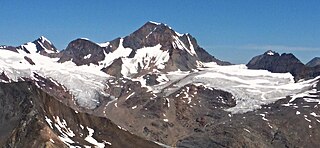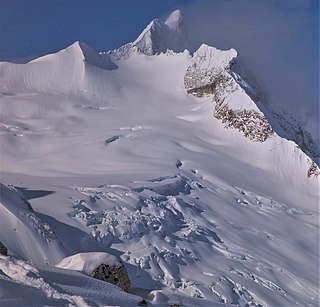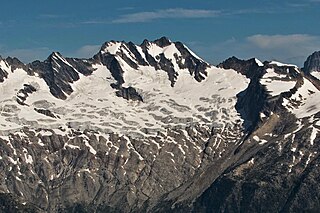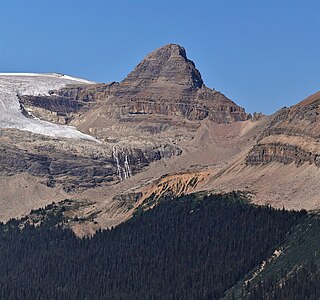
Snowpatch Spire is a mountain peak in British Columbia, Canada. With its first ascent in 1940, it was the last of the Bugaboo Spires to be climbed. It is located southwest of the Conrad Kain hut, between Bugaboo, Vowell and Crescent Glaciers, at the south end of Bugaboo Provincial Park. The mountain's toponym was officially adopted October 29, 1962, by the Geographical Names Board of Canada.

Howser Spire, or Howser Spire Massif, is a group of three distinct granite peaks, and the highest mountain of the Canadian Bugaboo Spires. The mountain is located at the southwest corner of the Vowell Glacier, within the Bugaboo mountain range in the Purcell Mountains, a subrange of British Columbia's Columbia Mountains, The highest of the three spires is the North Tower at 3,412 m (11,194 ft), the Central Tower the lowest, and the South Tower is slightly lower than the North at 3,292 m (10,801 ft).

Joffre Peak is a 2,721-metre (8,927-foot) mountain summit located in the Coast Mountains, in Joffre Lakes Provincial Park, in southwestern British Columbia, Canada. It is the second-highest point of the Joffre Group, which is a subset of the Lillooet Ranges. It is situated 26 km (16 mi) east of Pemberton and 11 km (7 mi) northeast of Lillooet Lake. Joffre is more notable for its steep rise above local terrain than for its absolute elevation as topographic relief is significant with the summit rising 1,500 meters (4,920 ft) above Cayoosh Creek in 4 km (2.5 mi). The nearest higher peak is Mount Matier, 1.6 km (1 mi) to the south. The mountain's climate supports the Matier Glacier on the southwest slope, and the Anniversary Glacier on the southeast slope. Precipitation runoff from the peak drains into Joffre Creek and Cayoosh Creek which are both within the Fraser River watershed.

Eyebrow Peak is a prominent 3,362-metre (11,030-foot) glaciated mountain summit located in the Purcell Mountains in southeast British Columbia, Canada. It is the ninth-highest peak in the Purcells. It is situated 28 km (17 mi) south of The Bugaboos, 44 km (27 mi) west of Invermere, 6 km (3.7 mi) north of Mount Monica, and 18 km (11 mi) east of Duncan Lake. Its nearest higher peak is Commander Mountain, 11.4 km (7.1 mi) to the southeast. The first ascent of the mountain was made in 1914 by Edward Warren Harnden, D. Brown, L. Nettleton, and E. Parson via the west slopes. The name Eyebrow Peak came about by Arthur Oliver Wheeler in 1910 when viewing two broad rock scars near the summit, and their arrangement in connection with the surrounding snow created the appearance of enormous eyebrows. However, using the same sightings as Wheeler, Professor Peter Robinson showed that Wheeler actually saw Mount Farnham. Poor weather conditions led to Wheeler's error, and the Eyebrow moniker was then moved to its present location. The mountain's name was officially adopted June 9, 1960, by the Geographical Names Board of Canada.

Deluge Mountain is a mountain summit located in British Columbia, Canada.

Taurus Mountain is a mountain summit located in British Columbia, Canada.

The Virgin is a mountain summit located in British Columbia, Canada.

Barbette Mountain is 3,072-metre (10,079-foot) summit located on the shared border of Alberta and British Columbia, Canada.

Anniversary Peak is a 2,947-metre (9,669-foot) summit in The Bugaboos of British Columbia, Canada. It is located southeast of the Bugaboo Glacier, on the southern boundary of Bugaboo Provincial Park. Precipitation runoff from Anniversary Peak drains into Bugaboo Creek which is a tributary of the Columbia River. Anniversary Peak is more notable for its steep rise above local terrain than for its absolute elevation as topographic relief is significant with the summit rising 1,350 meters (4,429 ft) above Bugaboo Creek in 4 km (2.5 mi).
Mount Conrad is a 3,279-metre (10,758-foot) mountain summit in British Columbia, Canada.

Howser Peak is a 3,094-metre (10,151-foot) summit in The Bugaboos of British Columbia, Canada. It is located south of the Bugaboo Glacier and is the southernmost point of Bugaboo Provincial Park. Precipitation runoff from Howser Peak drains north into Bugaboo Creek which is a tributary of the Columbia River; as well as south to Duncan River via Howser Creek. Howser Peak is more notable for its steep rise above local terrain than for its absolute elevation as topographic relief is significant with the south aspect rising 1,380 meters (4,527 ft) in 2.5 km (1.6 mi).

Flattop Peak is a 3,063-metre (10,049-foot) summit in British Columbia, Canada.

The Four Squatters is a 3,072-metre (10,079-foot) mountain in British Columbia, Canada.

Mount Proteus is a 3,198-metre (10,492-foot) mountain summit in British Columbia, Canada.

Pequod Mountain is a 2,979-metre (9,774-foot) summit in British Columbia, Canada.

Moby Dick Mountain is a 3,154-metre (10,348-foot) summit in British Columbia, Canada.

Wrong Peak is a 2,869-metre (9,413-foot) summit in British Columbia, Canada.

Mount Duncan is a 3,202-metre (10,505-foot) summit in British Columbia, Canada.

Northpost Spire is a 2,911-metre (9,551-foot) peak in British Columbia, Canada.

Isolated Peak is a 2,845-metre (9,334-foot) summit in British Columbia, Canada.






















